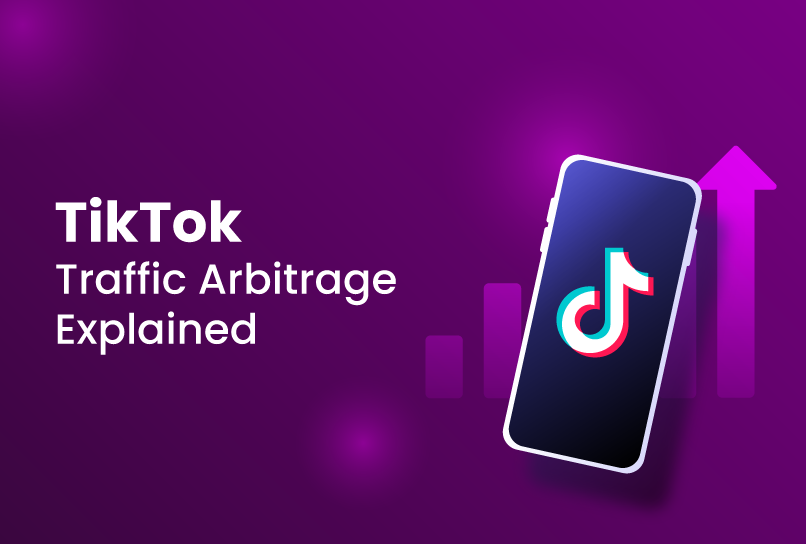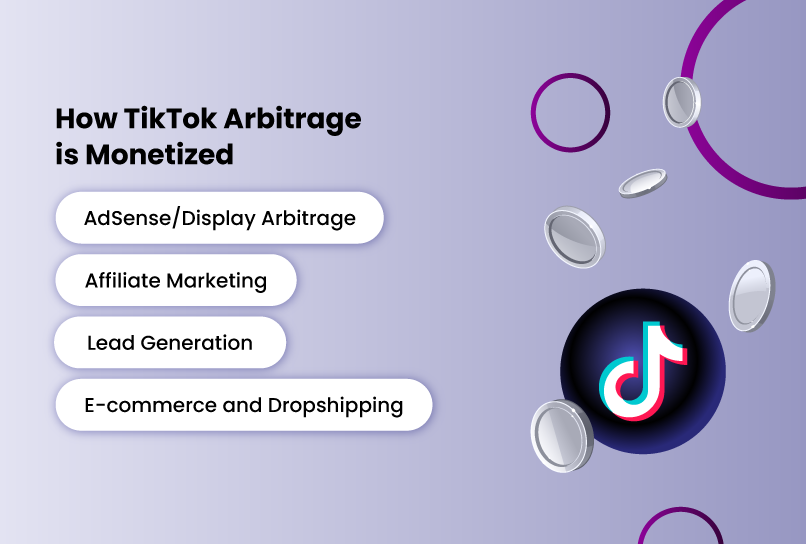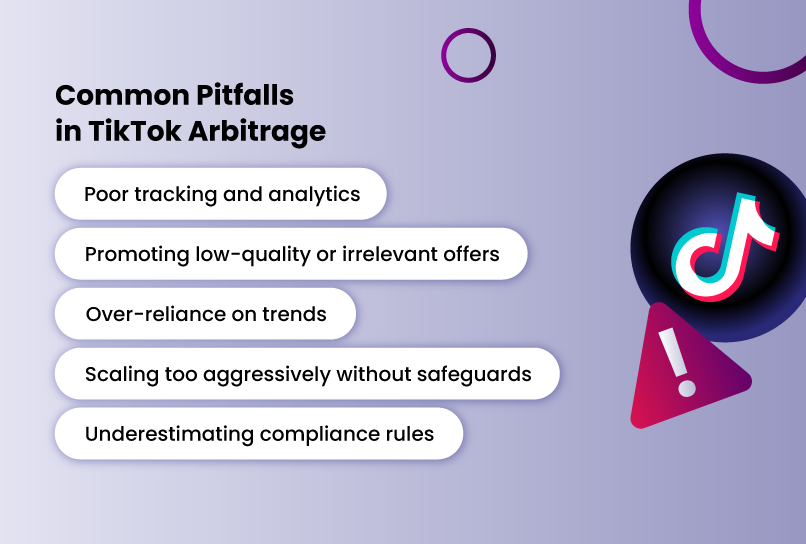TikTok isn’t just a hub for viral dances and memes anymore; it’s one of the most powerful traffic sources for digital marketers and arbitrageurs.
With over 1 billion monthly active users and some of the highest engagement numbers of any social platform, TikTok has become a goldmine for driving cheap traffic and monetizing it through multiple channels. It offers opportunities that other OG platforms like Facebook and Google can’t always match.
At its core, traffic arbitrage is simple: you pay less for traffic than you earn when you monetize it. On TikTok, this means leveraging its highly engaged, trend-driven audience and primarily young users with a strong appetite for impulse buys and viral content.
This guide breaks down everything you need to know about TikTok arbitrage: from understanding how it works and which monetization models to use, to scaling your efforts without falling into the common pitfalls. If you’ve been wondering how to tap into TikTok as a traffic source, you’re in the right place.
Understanding Traffic Arbitrage on TikTok
TikTok arbitrage is the practice of using TikTok as your primary traffic source—either through ads or viral content—and then directing that traffic to places where you earn more money than you spent or invested. The idea is simple: capture TikTok users’ attention cheaply and monetize it more profitably elsewhere.
To understand this better, let’s step back. Traffic arbitrage in general means buying or generating low-cost traffic and redirecting it toward higher-paying monetization sources, such as display ads, affiliate offers, or e-commerce products. In other words, you’re profiting from the spread between what traffic costs you and what it earns you.
What makes TikTok arbitrage unique is the platform’s design. Unlike Facebook or Instagram, TikTok’s algorithm promotes content from new accounts just as much as from established ones. That means even beginners can break through quickly. TikTok’s short-form videos naturally generate high click-through rates (CTR), and the platform’s trend-driven culture makes it easier to engineer virality.
It’s also important to distinguish TikTok arbitrage from affiliate marketing. Affiliate marketing focuses on closing sales through promotions. Arbitrage is broader—it maximizes traffic and impressions, even if the eventual revenue comes indirectly.
Examples of TikTok arbitrage in action include:
- A viral TikTok video leads viewers to a blog post monetized with Google AdSense.
- A TikTok ad pointing directly to a CPA (cost-per-action) offer landing page.
In short, TikTok arbitrage combines the fundamentals of traffic arbitrage with the explosive reach and engagement of TikTok’s algorithm-driven ecosystem.
Why TikTok is a Great Source For Traffic Arbitrage
TikTok is one of the fastest-growing social platforms in the world, and for arbitrageurs, it represents an unrivaled traffic engine. With over 1.5 billion monthly active users, its audience is not just massive—it’s engaged. Statista data shows that the 18–34 age group dominates TikTok’s user base, spending an average of 55 minutes per day on the app. The platform has strong adoption in the U.S., Europe, and Asia, giving it global reach for campaigns that scale across regions.
The real magic lies in TikTok’s For You Page (FYP) algorithm. Unlike Instagram or YouTube, TikTok doesn’t rely primarily on follower counts. Instead, it serves videos based on user interests and engagement patterns. This means a brand-new account has the same chance to go viral as an established one, allowing arbitrageurs to test and scale new campaigns quickly without years of audience building.
Done right, TikTok provides a steady stream of highly engaged traffic that can be funneled into multiple monetization models.
How TikTok Arbitrage is Monetized
Once you have traffic flowing from TikTok, the next step is monetization. The platform’s flexibility allows arbitrageurs to experiment with several models like the following:
AdSense/Display Arbitrage
This is one of the simplest entry points because it is easy to start and scalable. You drive TikTok traffic to a blog or viral content site that runs ads (Google AdSense, Mediavine, etc.). Every pageview earns you ad revenue. The downside is that revenue per thousand impressions (RPM) can be low, especially in less lucrative niches.
Affiliate Marketing
TikTok traffic can be redirected to affiliate offers where you earn commissions per sale (CPS) or per action (CPA). For example, a short video on “easy weight loss hacks” can link to a weight-loss product. It works well for niches like fitness, finance, or digital tools. However, it requires you to create compliant messaging to avoid bans.
Lead Generation
Instead of pushing for immediate sales, you can funnel TikTok users into email lists or lead forms. Once collected, leads can be monetized through email marketing campaigns in high-value niches like finance, real estate, or insurance.
E-commerce and Dropshipping
TikTok is notorious for making products go viral overnight. Arbitrageurs often drive traffic from TikTok to Shopify or print-on-demand (POD) stores. The model relies on the arbitrage of cheap TikTok ads against high-margin products.
Common Pitfalls in TikTok Arbitrage
TikTok arbitrage looks deceptively simple: make videos, get traffic, redirect it to monetization channels, and profit. But in practice, there are several traps that beginners and even experienced marketers often fall into. Avoiding these pitfalls can save you time, money, and frustration.
Poor tracking and analytics
The most common mistake is jumping in without proper tracking. Many arbitrageurs measure “views” or “likes” instead of the metrics that matter: earnings per click (EPC), cost per acquisition (CPA), and return on investment (ROI). If you don’t know exactly how much each click is worth, you’re essentially flying blind. This often leads to campaigns that look successful on the surface but are actually losing money once ad spend is factored in.
Promoting low-quality or irrelevant offers
TikTok users are savvy. They can spot clickbait or low-value offers quickly. Sending viral traffic to poor-quality landing pages or shady affiliate products creates two problems: high bounce rates (which TikTok’s algorithm punishes) and wasted traffic that doesn’t convert. Instead of chasing the highest commission, focus on offers that align with TikTok’s user base—impulse buys, entertaining products, or useful hacks.
Over-reliance on trends
TikTok thrives on trends: dances, challenges, viral sounds. While trends can skyrocket your traffic overnight, they are unstable. A campaign built entirely around a trending meme might collapse in days when the trend fades. The best arbitrageurs balance short-term “trend chasing” with evergreen content niches like personal finance, DIY, or gadgets that consistently attract clicks.
Scaling too aggressively without safeguards
Growth is exciting, but scaling without the right setup often backfires. TikTok enforces strict policies and can ban accounts in bulk if it detects suspicious activity. Many beginners run multiple accounts from the same phone or browser, thinking TikTok won’t notice. But TikTok’s detection system goes far beyond IP addresses—it uses browser fingerprinting and device signals to identify linked accounts. When one gets banned, the entire cluster often goes down.
Underestimating compliance rules
TikTok bans aggressive affiliate promotions, misleading health claims, or “get rich quick” style content. Accounts that push these boundaries often see reduced reach before being banned outright. Worse, TikTok sometimes bans ad accounts with no warning. The takeaway: if your content doesn’t look and feel native, TikTok will penalize you.
In short, TikTok arbitrage isn’t about hacking the system—it’s about understanding how TikTok works and playing within its guardrails while optimizing everything behind the scenes.
Multi-Accounting and Scaling TikTok Arbitrage
The real money in TikTok arbitrage comes from scale. One account might generate a few hundred dollars a month if it consistently goes viral. But professional arbitrageurs don’t stop at one. They build networks of 5, 10, even 50+ accounts across multiple niches, each one driving traffic to different offers. This diversification spreads risk and maximizes revenue potential.
For example, one might run 3 accounts focused on finance hacks, 2 accounts posting gadget reviews, 2 accounts in lifestyle/DIY, and 1 entertainment/meme compilation account. Each account serves as its own traffic funnel. If TikTok bans one, the others continue running, keeping revenue flowing.
There is a catch, though: TikTok is designed to detect multi-accounting. If you run multiple accounts from the same device or browser, TikTok can easily link them together. It doesn’t just look at IP addresses—it uses a technology called browser fingerprinting.
Browser fingerprinting collects dozens of data points about your browser, more than just cookies. It happens under the hood because it uses the exact tech that allows you to surf the internet. For instance, some of the data points collected are the list of fonts installed on the PC, the browser type, and the screen resolution.
Together, these signals create a unique “fingerprint” that TikTok uses to recognize users across sessions. If you open five accounts from the same browser, they all share a nearly identical fingerprint. Once one account gets banned, TikTok can automatically associate and restrict the others.
Thus, scaling arbitrage is not just about making more accounts. It’s about making them look and behave like independent, authentic users. That’s why Incogniton is indispensable. It protects your accounts from TikTok’s detection systems and allows you to grow sustainably instead of constantly starting over from scratch.
Taking It a Step Further With Incogniton
Traditional browsers like Chrome or Edge don’t separate these fingerprints. Anti-detect browsers like Incogniton solve this problem by letting you create multiple isolated browser profiles. Each profile has:
- Its own unique browser fingerprint (as if it were a different physical device).
- Independent cookies, caches, and local storage.
- The ability to run on a separate proxy IP (residential or mobile).
In practice, this means you can manage 10 TikTok accounts, and TikTok will see them as 10 completely different people using 10 different devices in different locations.
The benefits of using Incogniton for TikTok arbitrage:
- Reduced ban risk: Accounts aren’t linked, so if one gets banned, the others remain safe.
- Scalability: Easily log in and manage dozens of accounts without juggling devices, as many would have to do to get around TikTok’s tracking system.
- Efficiency: Switch between profiles with a click, instead of managing multiple physical setups. The browser also comes with automation features that you can use to manage routine tasks and free up more time for high-level, impactful work.
Conclusion
TikTok arbitrage opens up opportunities that were once exclusive to Facebook and Google. But arbitrage on TikTok isn’t “set it and forget it.” Success comes from understanding the platform’s algorithm, picking the right niches, using the right tools, and scaling safely with multi-accounting setups.
For beginners, the best move is to start small, test aggressively, and learn what converts. For experienced marketers, TikTok’s algorithm and cheap traffic represent one of the best arbitrage opportunities of the decade, as long as you play it smart.
Frequently Asked Questions
Is TikTok arbitrage the same as affiliate marketing?
Not exactly. Affiliate marketing is about earning commissions by selling products or services directly. Arbitrage is broader: you profit from the spread between traffic cost and monetization value, whether that’s through ad impressions, affiliate offers, or e-commerce sales.
How much money can you make with TikTok arbitrage?
There’s no fixed figure. Some newcomers lose money due to poor tracking or low-quality offers, while experienced arbitrageurs running multiple accounts often scale to thousands of dollars monthly. Your results depend on niche choice, monetization model, tracking discipline, and how well you scale.
What’s the difference between paid and organic TikTok arbitrage?
Paid arbitrage uses TikTok ads to send traffic to monetized destinations—reliable but requires upfront spend. Organic arbitrage relies on viral content to drive “free” traffic. Both work, but organic has a lower cost and higher volatility, while paid offers control and scalability.
Is TikTok arbitrage legal?
Yes, as long as you follow TikTok’s policies and avoid deceptive or non-compliant promotions. The key is to make content look native, provide real value, and avoid violating ad guidelines.
Anti-Detect Browser for Multi-Account Management
Manage unlimited virtual profiles for easy multi-account management. Safe and anonymous. Ideal for teams and individuals. Download and try for free now!



